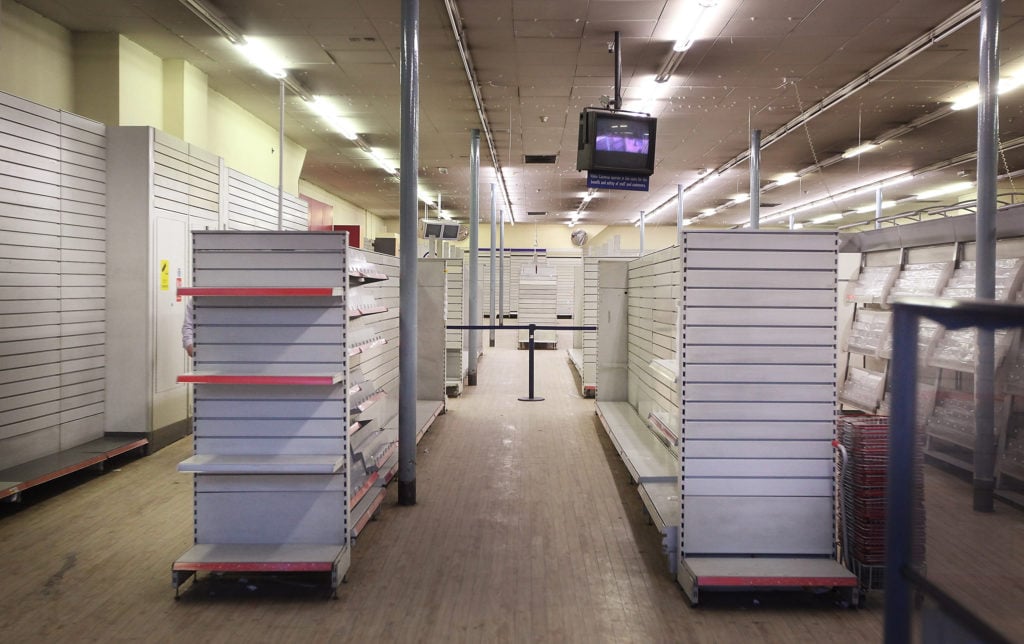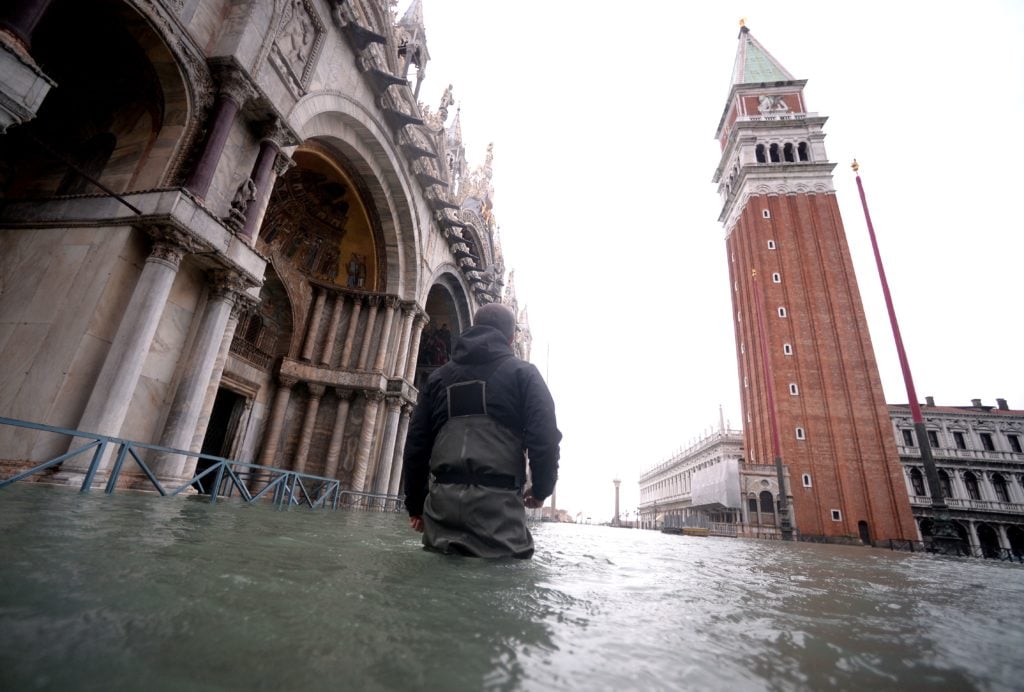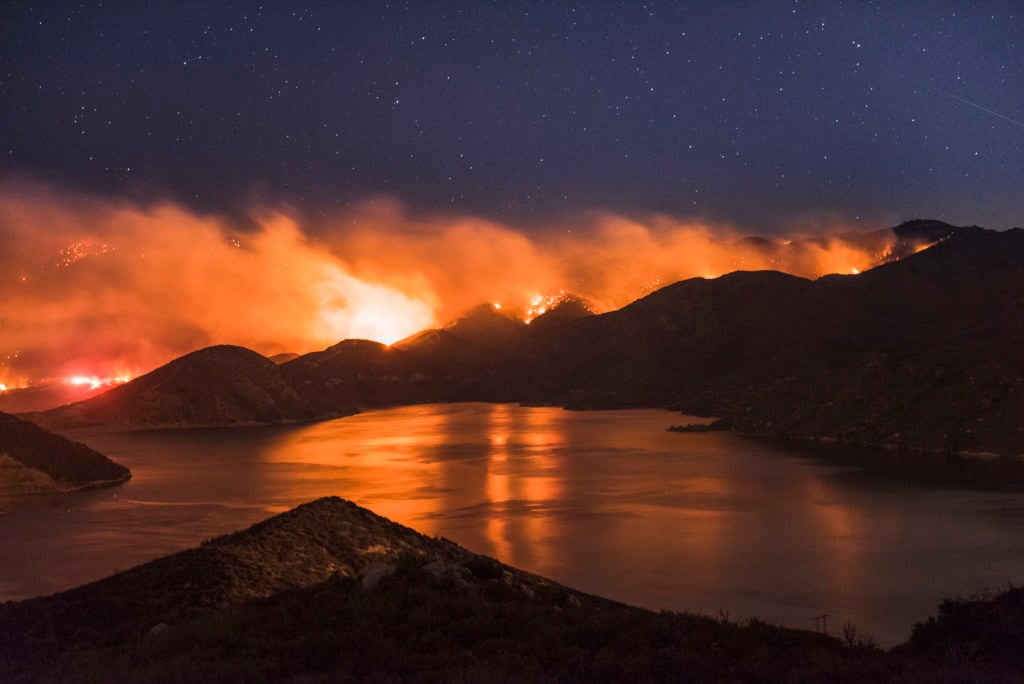Every Monday morning, Artnet News brings you The Gray Market. The column decodes important stories from the previous week—and offers unparalleled insight into the inner workings of the art industry in the process.
This week, following the fuse from present-day threats to future ones…
FIRESTORM
On Tuesday, as wildfires continued to devour millions of acres of the US’s west coast, the New York Times Magazine and ProPublica published a harrowing thinkpiece titled “How Climate Migration Will Reshape America.” Although the arts make no more than a fleeting cameo in the text, the ecological trend lines it maps out point to dramatic implications for the art world—now and for decades to come.
Written by Abrahm Lustgarten (with bravura photography by Meridith Kohut), the piece synthesizes reporting, statistical modeling, and data visualizations to project the myriad effects of increasingly extreme heat, ascendant sea levels, and frequent superstorms on core aspects of American life. Through this prism, Lustgarten teases out how the worsening climate is likely to impact everything from the real-estate and job markets, to food and water supplies—and with them, migration patterns that will exert even more pressure on those same factors once Americans actually start moving en masse.
How does Lustgarten think the US map will be redrawn? The evidence points to a second Great Migration north, particularly towards the largest cities of the American Northwest and Northeast—only this time for reasons based on climate change rather than Civil Rights.
For example, he projects that it won’t be enough for Southern Californians to hightail it to the Bay Area. (This will not be news to anyone who encountered the recent dystopic photos of San Francisco blanketed by a wildfire-induced orange haze that made the city look eerily reminiscent of that proto-Instagram-bait Olafur Eliasson made for Tate Modern in 2003.)
Instead, the evidence leads Lustgarten to unfurl a vision of the US only a few decades from now in which “a high-speed rail line could race across the Dakotas, through Idaho’s up-and-coming wine country and the country’s new breadbasket along the Canadian border, to the megalopolis of Seattle, which by then has nearly merged with Vancouver to its north.”
On the opposite coast, current trends suggest New York won’t just endure the pending ecological catastrophe; it will actually expand as a result of climate change. If you’re concerned about the city’s proximity to the Atlantic’s rising tides and steadily more violent hurricanes, remember that the Army Corps of Engineers already began investigating the construction of an enormous seawall to protect it, at a cost estimated between $62 billion and $119 billion… until the Trump administration froze the project in February 2020.
But the reasons for New York’s likely longevity as a destination city ferry us to the most alarming reality of climate change: if ecologically feasible, its richest residents can, and likely will, spend their way to safeguarding their homes. Meanwhile, what Lustgarten writes about the Bay Area will hold true everywhere: “Latino, Asian, and Black communities who live in the most-vulnerable low-lying districts will be displaced first.”
In other words, a United States reshaped by ecological extremes will be a United States that even more aggressively foregrounds the nation’s already brutal wealth disparity, as well as the weighty racial injustices built into it. And it’s here that climate change demands we connect to the art world, even in the immediate term.

Empty shelves line a closed Woolworths branch after the last day of business in London on January 6, 2009. Photo by Peter Macdiarmid/Getty Images.
EVACUATION PLANS
The same day Lustgarten’s opus went live online, Zachary Small penned a feature for us at Artnet News about the “brain drain” of talent from museums and arts nonprofits on both sides of the Atlantic. From layoffs to resignations, the piece adds stories of multi-decade veterans and entry-level strivers fleeing the industry in droves, giving qualitative weight to the quantitative scaffolding seen in multiple recent reports on the dwindling opportunities in arts employment.
While the pandemic and its accompanying economic volatility have accelerated the exodus from arts work, Small’s reporting reinforces that longstanding structural inequities concerning race, gender, and—perhaps most of all—class are pushing a diverse group of talent toward the exits well before the dawn of the social-distancing era. Lucy Charlotte, a 25-year-old British nonprofit worker with a graduate degree in art history and not a single job interview to show for 18 months of applications in the cultural field, hit the problem right between the eyes:
“The people who get to stay in the art world are those who can afford to work for nothing,” Charlotte says. “The pandemic was just the final straw.”
One of the reasons for this trend, of course, is that the pillars of the art establishment stand in urban centers where the cost of living is astronomical. In the US, that primarily means New York and Los Angeles, with the likes of Chicago, Miami, and maybe even Boston arguably forming a second tier thanks to their institutional and/or art-fair bona fides. As fate would have it, Lustgarten identifies that “eight of the nation’s 20 largest metropolitan areas—Miami, New York, and Boston among them—will be profoundly altered” by unchecked climate change, “indirectly affecting some 50 million people” before the century’s end.
About Los Angeles: even as the city seemingly solidifies its status as a global arts hub, California as a whole is becoming increasingly uninhabitable. Mark Arax, a 50-year resident of the Golden State whose writing has repeatedly attempted to tunnel into California’s unique history and culture, published an essay last Friday declaring the state to be “one of the most calamitous places on earth” due to its rotating menu of “drought, flood, wildfire, mudslide, [and] earthquake.” All of these natural disasters, of course, are primed to become more severe and more frequent as climate change worsens.
So it’s no surprise Lustgarten relays that, during the fall 2019 fire season, Jesse Keenan, an advisor on looming dangers to the financial system for the Commodity Futures Trading Commission, the federal agency that regulates Wall Street’s derivatives market, began fielding calls from a steady stream of anxious “private-equity investors and bankers all looking for his read on the state’s future.” According to Keenan, it was a new manifestation of “investor-grade nervousness” about California’s real-estate market. It also gels with findings that, between 2018 and 2019, the number of people moving out of the state outweighed the number moving in for the first time since the 2010 census.
In other words, if the wider art world is ready to fully embrace the organic cultural scene Los Angeles has fostered for decades, its members would be wise to plan on a relatively short stay—and to keep their bug-out bags close.

A man walks in flooded St. Mark square in Venice, during “acqua alta,” or high water, of over five feet on November 17, 2019. Photo by Filippo Monteforte/AFP via Getty Images.
MORE OF THE SAME
What’s the upshot for the US art industry if events unfold as Lustgarten imagines? The simple answer is that New York remains a global capital, and the southern hubs relocate north. Maybe LA expats cluster in that Seattle-Vancouver supercity he teased. Maybe climate refugees from Miami join the throngs seeking shelter and prosperity in the seawalled Big Apple. Almost undoubtedly, some artists, dealers, and collectors will break off and bolster newly temperate, newly powered-up cities like Milwaukee, Buffalo, and Duluth.
But regardless of the geographical destination points, the structural effects on the art-world talent pipeline will be the same. As Lustgarten brings into focus, climate migrations almost inevitably lead to increased urbanization, because people go where the resources are. The problem is that the cost of the resources, including basics like water and food, will only spike higher as the population does the same. Competition for jobs will become fiercer, too, meaning wages will in many cases drop. Livable, let alone genuinely desirable, real estate will become scarcer.
All of which means the arts—a field whose unforgiving employment economics have already led to a hemorrhaging of talented BIPOC and women at a time when fresh perspectives and new ideas are most needed to reform a creaky system—would only become even less welcoming. Or at least, even less welcoming to anyone except beneficiaries of generational wealth and the nation’s longstanding structural injustices (see: well-off white people, mainly men). If “the clock is ticking backwards on the evolution of museums,” as a digital-media producer recently laid off by the Peabody Essex Museum told Zachary Small, then climate displacement threatens to snap off the hands for good.
What can the arts do to combat this distressing future? In tangible terms, very little. As some residents of the art world could stand to be told more often, we don’t actually matter anywhere near as much as we like to think. Air freight, which the industry has transformed into its great climate hobgoblin, only produces about 0.2 percent of the world’s annual carbon emissions, according to entrepreneur and consultant Nicholas Russell. That’s all air freight, by the way, not just art-industry air freight, meaning our trade’s impact in this particular facet of the climate-change puzzle is vanishingly small.
This isn’t to say the art industry is ecologically powerless. For instance, Russell argues it would be vastly more meaningful to refocus the industry’s green inclinations on its buildings: first, by reducing their energy consumption; second, by shifting to renewable energy sources; and finally, by prioritizing sustainable architecture at all opportunities. (And to be clear, people working hard to reuse shipping crates, travel by train, and/or convert to paperless offices still deserve credit for their mindset.)
Still, even the best-designed of these efforts only produce meager benefits relative to the root of the climate problem, which extends to the industrial and regulatory levels. What put us on this catastrophic trajectory isn’t that we’ve been shipping too much art, or even that we’ve been flying to too many art fairs. It’s that Big Oil has spent decades camouflaging the fact that your plastic was never actually going to be recycled; that the federal government subsidized regular people to live in arid climates and farmers to opt out of planting drought-resistant crops; and that insurers incented property-owners to rebuild over and over again on land that only gets more vulnerable to climate disasters every year.
The art world can, and should, organize to support ambitious environmental policy at the highest level. But the point here is that ecological justice is not only ecological justice. As Lustgarten demonstrates, a civilization at the mercy of climate change is a civilization that aggravates deep-seated structural discrimination along race, gender, and class lines. Anyone concerned about the latter should be equally concerned about the former, and vice versa, whether we’re talking about the art industry or American life in general. Because in the end, evacuating the perils in one area only helps if you don’t find even worse problems wherever you land next.
[The New York Times]
That’s all for this week. ‘Til next time, remember: when you feel the heat around the corner, make sure you know what’s worth taking with you.








